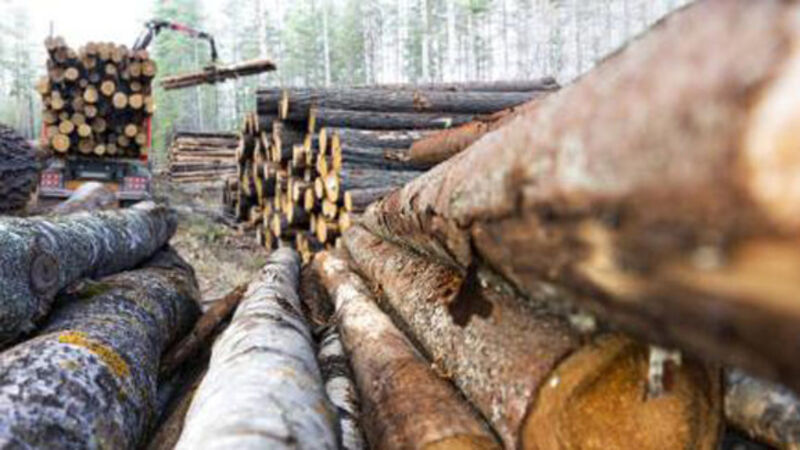Prepare for timber harvest to double in the next decade

Not bad for a 100% indigenous industry, providing jobs to many parts of rural Ireland where employment is hard to find.
In recent years, timber sawmill companies have invested more than €200m in extra processing capacity, largely on the basis of an expected increased volume of saw-log from the privately owned forestry sector.
The private forestry sector consists of 20,592 individual growers who own 28,756 parcels of forestry, with an average size of less than nine hectares per parcel.
According to Teagasc, by 2012, 26 private forestry owner/grower groups had been formed, to bring private forestry growers together.
The future role of these groups will be demanding and wide ranging, if they are to provide the comprehensive service needed by members who have substantial areas of forest approaching maturity and destined for clear-felling.
Group services will include arranging group thinning of plantations, harvesting of forestry crops, and organising the logistics of mobilisation and transport of saw-log from small and fragmented sites to sawmills.
Grower groups will ideally need resources and personnel for:
- Sourcing and compiling data on market prices in relation to saw-log, pulp wood and biomass material;
- Negotiating group sales of saw-log and pulp-wood to the processing sector;
- Organising group thinning and harvesting of small, fragmented forestry crops by harvesting contractors;
- Organising the logistics of forestry saw-log mobilisation and transport to sawmills;
- Ensuring best standard practices in relation to thinning and harvesting.
It is unlikely that this level of service can be provided on a purely voluntary basis. It may be necessary for grower groups to employ at least one staff member.
Invariably, this will have financial implications for grower groups, who should at the preliminary stage at least, receive some financial assistance from the State to help them get established and be capable of providing a crucial service to private owners, which would also greatly benefit harvesting contractors, sawmills, haulage contractors and the whole forestry and timber industry.
At the National Timber Transport Conference in Athlone last October, concerns were expressed by the Forestry Industry Transport Group (FITG) about the difficult challenge of mobilising timber from small fragmented privately owned plantations, with poor access, third or fourth class by-roads, and planning restrictions on private forestry entrances off public roads.
It was stated at the conference that over 100,000 lorry loads of timber per year are currently being transported on the rural road network, and this figure is set to increase substantially, in line with private forestry production output.
Teagasc has also highlighted the need to address “mobilisation” of timber from private forests to processing mills, and the need to improve the supply chain, as the timber supply from private forests increases.
Teagasc forestry staff say the fragmented nature of the private forest estate could pose a big timber supply problem. They welcome the emergence of forest owner groups.
A Teagasc spokesperson said: “All the necessary support should be provided so that these groups can progress to their full potential with the development of economies of scale in harvesting and marketing of their timber.”
Until recently, almost 80% of saw log processed by sawmills was supplied by Coillte, plus some being imported, and a small amount coming from the private sector.
Private forestry only began in the mid to late 1980s, and it is still in its infancy. It’s also concerning that fewer than 15% of private forestry owners are currently members of grower groups.
The value of effective owner groups was strongly echoed at the Teagasc “Talking timber” conference at Tralee last September.
Sean Moran, chairman of the Iveragh forestry owners group in South Kerry, listed many positive advantages for involvement in grower groups, especially in relation to marketing saw-log and pulp wood on a group basis, in addition to streamlining group thinning, and organising harvesting and transport of logs to sawmills on a group basis.
A knowledge transfer scheme was promised in the 2014-2020 forestry programme, and this must be delivered without delay.
It would help to offset any knowledge deficits that may exist amongst growers, especially to do with mobilising and disposing of their forestry crops, and realising the best possible value at the clear felling stage.
A suitable knowledge transfer scheme would also facilitate much greater numbers of private forestry owners becoming involved in grower groups, which would substantially improve their structures and capabilities.
Sawmills, harvesting contractors, and hauliers have until now been dealing mainly with one saw log supplier, Coillte, and would find it extremely difficult to deal individually with close to 21,000 growers, with an average plantation size of less than nine hectares.
The best practical way forward may be for for private forest owners to operate as compact, efficient and well-run organisations, capable of dealing and negotiating with sawmills, harvesting contractors and hauliers on a group basis, on behalf of their members.
Speaking on behalf of GP Wood, Enniskeane, Co Cork, Traolach Layton acknowledged the need for increased grower group involvement in procurement of private forestry. He emphasised the interdependence between processors and forest owners, and the need to build relationships that recognise their mutual dependence. Structures appropriate to facilitate efficient flow of logs from the forest to the market place are also needed, said Mr Layton.









